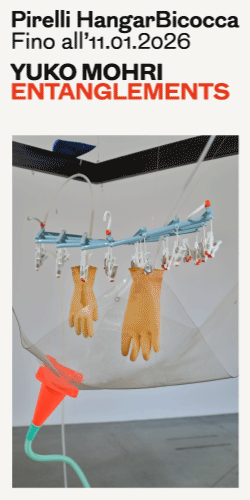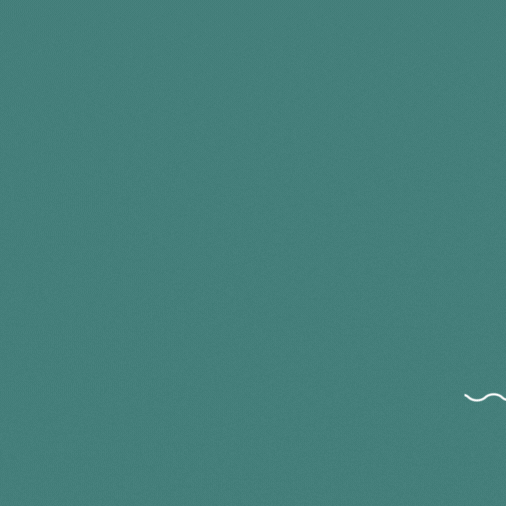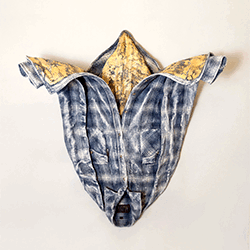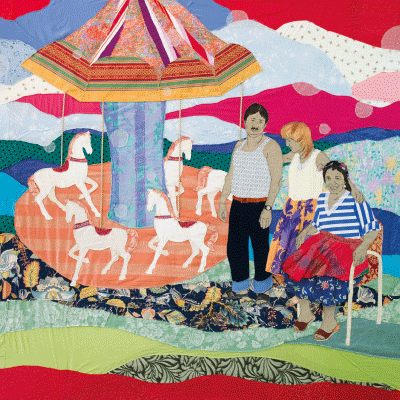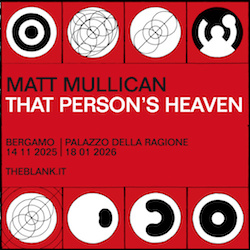
English interview below
“In termini marxiani l’infrastruttura (o “base”, ossia I modi di produzione) cambia prima della “sovrastruttura” (ossia l’ideologia e la cultura)” (Lev Manovich, “Software Culture”)
“The control of things over subjects is the control of the subjects over themselves”. Il titolo della prima personale di Daniel De Paula presso la galleria Francesca Minini evoca in maniera inequivocabile la situazione contemporanea in cui ci troviamo, ma non solo. Nella mostra, l’artista brasiliano, nato a Boston nel 1987, affida un ruolo importante al suo pensiero anche attraverso la parola: accompagnano la mostra un suo testo e alcuni estratti di un’intervista realizzata con Saskia Sassen, sociologa alla Columbia University, che guidano il visitatore in un paesaggio collassato, complici l’iperproduzione capitalistica e le speculazioni finanziarie (che si manifestano come una diretta e inevitabile conseguenza).
Una prospettiva di un’ipotetica redenzione (o nella peggiore delle ipotesi di una maggiore consapevolezza) dei meccanismi che governano il nostro sguardo e il nostro agire nel mondo, come dice De Paula: “Una struttura poliedrica e complessa che ha continuato a guadagnare potere negli ultimi trent’anni è l’alta finanza, un sistema che non ha nulla a che vedere con le banche tradizionali (…) La terra è vista come un bene desiderabile per costruire strumenti finanziari”.
Questa esperienza si manifesta, secondo De Paula, soprattutto nelle forme astratte di costruzione dello spazio su cui l’uomo proietta meccanismi di controllo su di sé, gabbie per una libertà “finita”. Per queste ragioni, in questo ruolo, la galleria si tramuta in un dispositivo spaziale per l’attivazione dello sguardo, trovando un fil rouge espositivo nei principi di modularità e verticalità, che si disseminano silenziosamente nello spazio come frammenti siderali.
La redazione di ATPdiary ha intervistato Daniel De Paula per scoprire come le opere in mostra, così come il suo ruolo da artista, manifestino questa critica antropologica (e antropocentrica) dagli importanti risvolti socio-economici, psicologici e comportamentali. Segue l’intervista in inglese –


“In Marxian terms the infrastructure (or” base “, that is, the ways of production) changes before the” superstructure “(that is ideology and culture)” (Lev Manovich, “Software Culture”)
“The control of things over subjects is the control of the subjects over themselves”. The title of Daniel De Paula’s first solo show at Francesca Minini Gallery unequivocally evokes the contemporary situation in which we find ourselves, but it doesn’t talk not only about that.
In the exhibition, the Brazilian artist, born in Boston in 1987, entrusts an important role to his thought also through the word: a text of his and some extracts of an interview made with Saskia Sassen, sociologist at Columbia University, accompany the exhibition. These instruments guide the visitor in a collapsed landscape, accomplices the capitalist hyperproduction and the financial speculation (a direct and inevitable consequence).
A perspective of a hypothetical redemption (or at worst of a greater awareness) of the mechanisms that govern our gaze and our actions in the world, as De Paula says: “A multifaceted and complex structure that has continued to gain power in the last thirty years is high finance, a system that has nothing to do with traditional banks (…) The earth is seen as a desirable asset for building financial instruments “.
According to De Paula, this experience is manifested above all in the abstract forms of construction of the space on which men projects control mechanisms on themselves as cages for a “finite” freedom. For these reasons, in this role, the gallery turns into a spatial device for the activation of the gaze, finding an exhibition fil rouge in the principles of modularity and verticality, which spread silently in the space like sidereal fragments.
ATPdiary interviewed Daniel De Paula to find out how the works on display, as well as his role as an artist, manifest this anthropological (and anthropocentric) criticism with important socio-economic, psychological and behavioral implications. Follows the interview in English –
Irene Sofia Comi: In the text that follows the exhibition, you talk about your research as a “critique to the production of space” as an expression of power relations and abstract social forms. Where and how do you perceive these references in your daily routine, and how do you elaborate them in your research?
Daniel De Paula: The critique of the production of space as the reproduction of relations of power is one of the underlining concepts present in my artistic investigations. Such interest emerges from the simple desire to comprehend the myriad of actions and forces that are concealed within the physicality that surrounds us. Somehow it represents a critical perspective towards the fundamental categories that constitute our present way of existence inside a modern capitalist society. In such manner, I understand that the physical space around us is not neutral, on the contrary, it is the material result and manifestation of extremely violent abstract social relations, such as, for example, capital, labor, and property. In such case, our quotidian coexistence within this system, physically mediated through architecture, infrastructure, commodities, landscapes, and material in general, is capable of informing our inquires and questions concerning the state-of-being of our society. Power flows through objects, not only electrical cables and energy generating infrastructure, but also in and out of every highway, shipping container, or wooden pallet. I am invested in my practice as an artist, referencing the architect Louis Kahn’s question “what does a brick want to be?”, to interrogate the material and physical structures that exist around us, acknowledging their active presence, yet also demanding from them some elucidation in regards to the reason and internal logic that they carry and that ultimately governs and controls our lives.

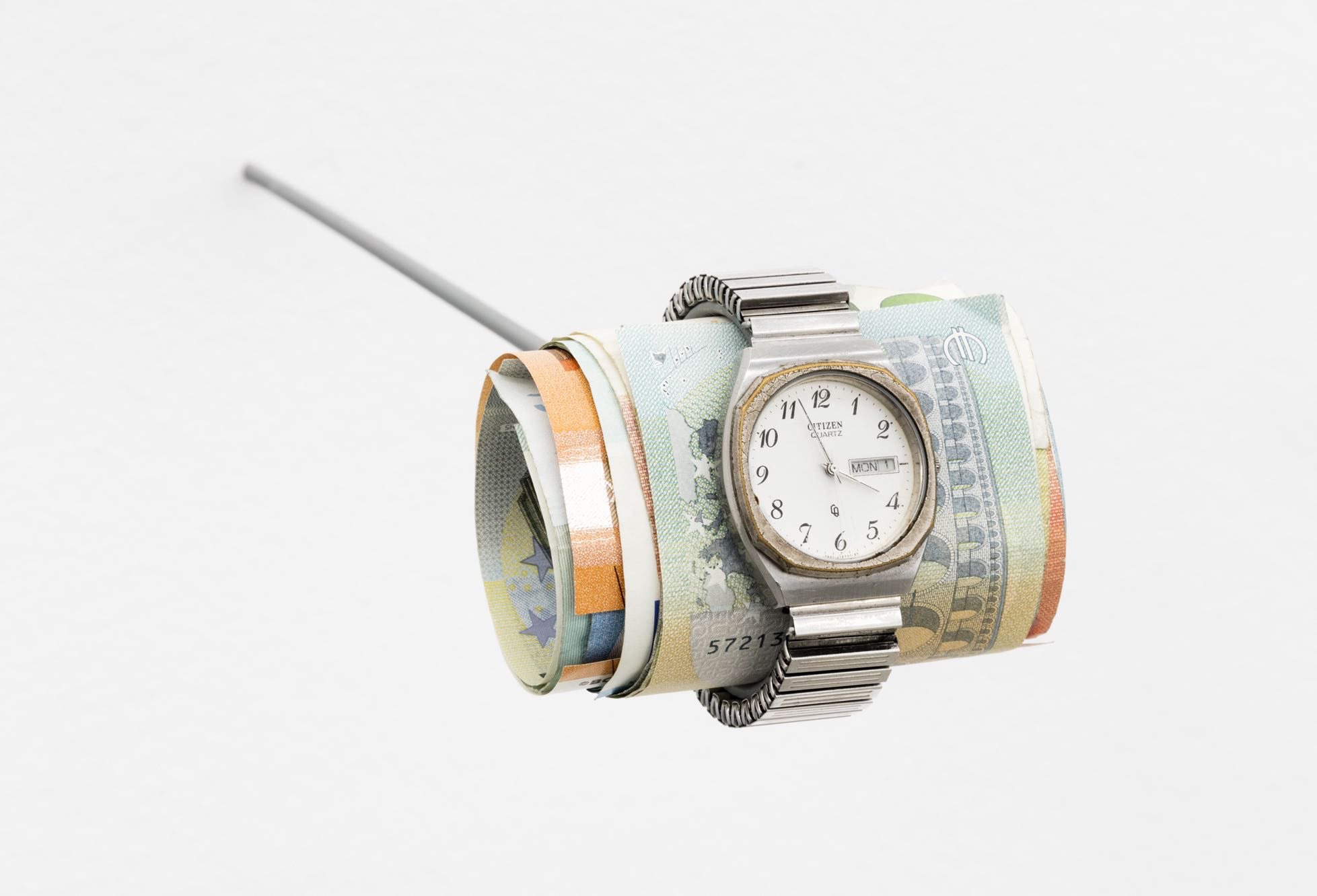
ISC: It’s possible to read the exhibition through the concept of modularity. I am thinking of the juxtaposition of elements shaping the sculptural works from the series inseparable spatial structures, or even by the choice to display and represent the video accumulation on a fragmented screen, composed of mobile and detached tiles belonging to single LED videowall mosaic. Why do you care about modularity? Could we associate this concept to the idea of ”grid” that ideally regulates what Benjamin would call our “optical unconscious“?
DDP: Industrial modularity is the physical manifestation of efficiency and progress, and it allows for the accelerated scaling-up of infrastructure and, consequently, the fluid movement of products, the incessant extraction of natural resources, the mobility of working populations etc. It represents the paradox of progress and exploitation. Scaffolds, screws, circuit boards, antennas, wires, trucks, bricks, tubes, and pipes are all components of a system that can be quickly expanded, dismantled, and reassembled, uneffected by the particularities of specific places or cultures, in like manner to a universal standard. Yet the universality of modular thinking in our society actually reveals our basic interests and necessities as individuals, which are basically to control and dominate the landscape in order to continuously produce and exchange commodities. Such cartesian modular spatial grid and its internal logic is a projection of our capitalist thinking, and it shapes space to the extent of normalizing and naturalizing standards, patterns, and modularity, finally conditioning our view towards the world to the point that our perception is now in itself embedded by a commodifying gaze, where everything and everyone is subject to the supposedly immutable existing reality, reduced to a commodity, a number, an object, a calculation, something that can be bought and sold, stripped from its subjectivity. Such process is of course a result of a technical and scientific thinking that has undeniably resulted in a collapsing world, even though it has masked itself as progress and development. In this train of thought the concept of the optical unconscious developed by Walter Benjamin, as well as that of the technical image proposed by Vilém Flusser, are key critical investigations towards the relationship between how we see things and how we do things.

ISC: An objectivized edge of structure and overstructure is shown through the exhibition. Naturalia et artificialia: a complex link of different strengths, singularity and collectivity, humankind and society. For instance, the materials you’ve used to create the sculptures could be, by their own and due to their ontological nature, the fil rouge constructing all the exhibition path… How does this continuous tension emerge in the sculptures? Can you give me some examples?
DDP: Through the procedure of appropriating a series of apparently distinct preexisting objects, all which are carefully sought out, and a result of extensive negotiations in order to be acquired, loaned, or supplied, I attempt to articulate a narrative capable of addressing a system beyond the formal qualities of the objects themselves. Each object is indissociable from the system it originates from, it is a fragment that contains a totality. My interest lies not on the material specificities of each object, such as what kind of rock or what color or brand of storage bin is being exhibited, but on the invisible thread that connects all these materials, activated by the events that have transpired in the vicinity of these things. All the items that are converted into artworks within my exhibitions are witnesses to the violent social relations that produce space, they are testimonials. Yet I wouldn’t be satisfied to limit the role of the works to simple evidentiary forms, material evidence capable of only addressing specific local contexts and violent circumstances. Therefore, through the juxtaposition of a multitude of objects and procedures, I attempt to present an over-arching structure, more complex and permeable, which implicates ourselves as well, and possibly undetectable and unpronounceable at first, and of which, I, myself, am continuously altering, as well as struggling to fully comprehend its precise meaning. Moreover, I, for example, purposely overlap objects that originate from a time related to modern capital, such as scaffolds, infrastructural cables, wristwatches etc., with materials that are related to a geological timeframe, for instance, meteorites, fossils, minerals etc., in an effort to, through a frictional contrast, elaborate a critique that is greater than the parts themselves, greater than specific objects of study or daily situations, heavier than any particular local context, and capable of phenomenologically affecting a public. I cannot, and also, must not, assert the effectiveness of such strategy, it is somehow a process, more than a formula or an answer, a dialectic movement, where finally I aspire to articulate a personal subjective language capable of not only declaring the violence present in the physical space around us, and the invisible forces that are concealed within it, but also able of producing and thinking towards radical ways of overcoming the forces that dominate us.

ISC: In the elements you’re talking about what comes up is a maybe not explicit but clear interest in the natural data… I’m thinking about the mineral resource or the geological deposits. And you do that speaking of financial speculation or structures created by man, projections – in your view – far away from the “truth of the things”. How do these aspects converge together in the video, the main technological protagonist of the show?
DDP: The video, simply titled accumulation,at first simultaneously refers to natural deposits of resources that accumulate in the earth’s strata, as well as the process of accumulation of capital, it is composed of a compilation of video-inspection footages of oil, water, geothermal energy, and gas extraction wells from across the globe. The images were all collected, by means of extensive negotiations over the course of 2 years, from several international companies that offer such services to oil and gas extraction industries as a maintenance procedure in order to find and repair cracks, leaks, obstructions and any other problems that might disturb the continuous extraction or resources. After the collection of the material I later structured it in such manner that, by means of a numerical depth reference present in all of the original footages, a continuous descent into the center of the earth is proposed. Every cut and transition in the video, from one extraction well to another, independent of the specificity of each global location or context, whether it is in Nigeria, Brazil, Canada, Australia or Norway, is constructed around the respective depth information of the descending camera, generating the impression of an eye continuously moving downward at the same temporary deepness within the crust of the planet. In like terms to other works present in the exhibition, the probing of a physical and conceptual multilayered vertical axis is in motion, in which things are more than what they seem at the surface, and where one might attempt to look for where the organizing principle of our late-capitalist society dwells. From corporate satellites to deep sea mining, from high-frequency financial trading antennas to underwater data cables etc., the sedimentation of actions and layers construct the train of thought that produces the space around us. Yet the video does not propose a resolution, an end, on the contrary it is an ongoing work, with open-ended duration in itself, and of which I will continuously add more imagery, and so, for this reason, it represents a method of investigation more than a conclusion. In such manner, I am not convinced by the idea of a singular final truth of things, but more of a continuous probing, and, to illustrate such practice, a citation that I consider relevant is Mao Zedong’s affirmation that “without fieldwork there is no right to speak”.
ISC: Can you imagine a world without objects, without what you call “constructions and strategies”? In other words, which could be the solutions for goods exchange between individuals in a post–capitalistic world? I think about your role as an artist inside the art world, a system that in the end necessarily reflects the socio–economic mechanisms on which our reality is constructed. So, in relation to the themes you report, which is your vision and how do you interpret your role?
DDP: I am aware that my practice, not only as an artist, but as an individual, sometimes also reproduces capitalist and violent forms. It is inevitable since there is no obvious outside option in opposition to this organizing societal structure. Therefore a dose of cynicism is necessary in order to survive. I also don’t believe in stagnation, accommodation, or immobility. I believe in critique, and consequently in a practice informed by critique, not simply a practice that exists only for the sake of doing something, usually such imperative of praxis can lead to the simple reproduction of what one might want to critique and overcome. Sometimes to obviously and explicitly disobey is the same as obeying. In such regards, as an artist I interpret my life as an attempt to practice radicality, not in an extraordinary way, but, unlike most individuals, as an artist, there is, or at least there should be, a different reward system at hand, not in a romantic manner, of course there are palpable hardships present, but there is, if one might suggest, a luxury that can be measured in terms of time, not simply by abundant wealth. Somehow art, and being an artist, relates to producing a different relation with time, and consequently with space. Such fundamental experience can somehow be a trigger to forms of overcoming the imminent collapse of the world, even if momentarily, or, even if through failure. Finally, at least some friction is produced, some force in the negative direction, against the flux of the present.





